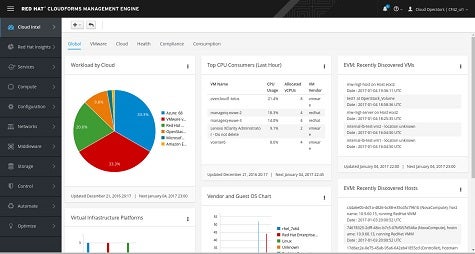One of the issues most IT organizations find themselves wrestling with is a need to master a wide variety of different tools to manage multiple aspects of the IT environment. Red Hat, for some time now, has been making the case for rationalizing all those tools via Red Hat CloudForms, a suite of management tools that IT organizations can use to manage disparate IT infrastructure.
This week, Red Hat announced it is extending the reach of Red Hat CloudForms for the first time into the realm of platform-as-a-service (PaaS) environments by adding support for JBoss, the open source PaaS environment owned by Red Hat.
Geert Jansen, product owner for Red Hat CloudForms at Red Hat, says Red Hat CloudForms 4.2 is intended to make it simpler to manage hybrid cloud computing environments. With that goal in mind, the new release enhances support for OpenStack by adding support for both Swift and Cinder storage technologies as well as deepening integration with Amazon Web Services (AWS) and Microsoft Azure. Support for JBoss is being made available in the form of a technology preview that will become more widely available in a future release of Red Hat CloudForms.
As IT organizations move to craft cloud computing environments that span public and private clouds, Jansen says many of them are discovering that trying to master multiple tools for managing every aspect of those environments winds up hindering the agility of the IT organization in a way that also drives up the total cost of operating the environment. Jansen says because of these issues, most IT organizations are now a lot more receptive to rationalizing the diverse number of management tools being employed today.
“Most IT organizations today are trying to do a lot more with less,” says Jansen.
To address that issue, Jansen says, Red Hat now bundles CloudForms with its offerings to provide customers with a standard approach to managing everything from servers and storage to containers.
Obviously, most IT professionals tend to favor one tool over another. But from a cost perspective, licensing those tools and then assigning someone to master them quickly becomes prohibitive. The better part of valor for most organizations will be to standardize on a common approach to managing multiple elements of the data center in a way that does more to promote cross-pollination of skills than it does to create expensive islands of IT specialization that are increasingly unnecessary.




